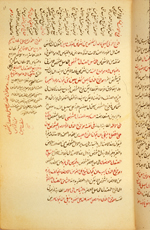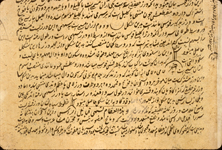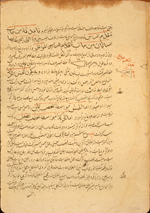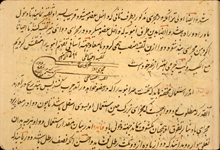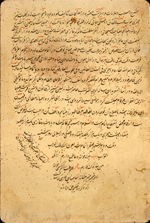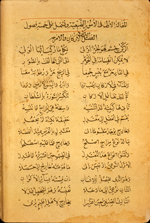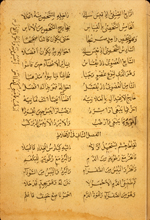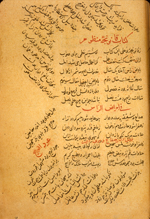Catalogue - Medical Encyclopedias
Commentaries
-
 Sharḥ al-mukhtaṣar mawsūm bi-Qānūnchah (MS A 68, item 1)
Sharḥ al-mukhtaṣar mawsūm bi-Qānūnchah (MS A 68, item 1) - (Commentary on the abridgement known as Qānūnchah)
- شرح المختصر موسوم بقانونچه
- by Ḥusayn ibn Muḥammad ibn ‘Alī al-Āstarābādhī (fl. 1427/831 H)
- حسين ابن محمد ابن على الاستراباذى
The Qānūnchah was a popular and short abridgement in ten chapters of the Qānūn, which the epitomizer, Maḥmūd ibn ‘Umar al-Jaghmīnī, disingenuously claims to have taken directly from the writings of ancient writers such as Hippocrates, Galen, and Ḥunayn ibn Isḥāq rather than from Ibn Sīnā (Avicenna).
NLM does not have a copy of the Qānūnchah itself, but it does hold in its collections copies of commentaries on it and two versifications of it. For copies of the Qānūnchah itself, see Iskandar, "Wellcome", p. 166-170; Iskandar, "UCLA", p. 67; Ann Arbor (Michigan), University of Michigan, Yahuda Collection, Islamic MS 613; and Savage-Smith, "Bodleian", MSS A. Walker 24 and Hunt 502.
The Qānūnchah has been published in an English translation, made from a Persian translation, as: Terjuma Canooche Mahmood Cheghmeny der Elm Tebb. Short Canons on the Art of Physic. Being a Compendium, both of Theory and Practice, written originally in Arabic; by Mahmood Cheghmeny: and now done into English, from a Persian Translation (Calcutta, 1782).
Ḥusayn ibn Muḥammad ibn ‘Alī al-Āstarābādhī wrote his well-known commentary on al-Jaghmīnī's summary of the Canon on Medicine of Ibn Sīnā (Avicenna) in the year 1427/831 H. Al-Astarabadi dedicated it to Prince Murtada.
For other copies of al-Āstarābādhī's commentary on the Qānūnchah, see Iskandar, "UCLA", p. 73; Iskandar "Wellcome", p. 184; and Savage-Smith, "Bodleian", MS Arab.e.178.
Sharḥ al-mukhtaṣar mawsūm bi-Qānūnchah (MS A 68 item 1)
Illustrations
A sample page from al-Āstarābādhī's commentary on the Qānūnchah. The latter was a brief summary made in the previous century by al-Jaghmīnī of the Canon on Medicine by Ibn Sīnā (Avicenna). It is an undated copy of probably the late 19th century.
Physical Description
Arabic. 127 leaves (fols. 5b-132b). Dimensions 21.2 x 12.2 cm; text area 14.7 x 7 cm; 18 lines per page.
This is an incomplete copy. The text breaks off abruptly at the bottom of fol. 132b in the midst of the 3rd section (fasl) of the 10th chapter (maqalah). The lower half of fol. 65a and all of 65b, and the upper half of 66a, as well as all of fols. 100b and 101a, were left blank by the scribe although there is no break in the text and nothing appears to be missing from the text at those points.
The copy is undated and unsigned. The appearance of the paper, script, and ink suggests a date of the late 19th century.
The text is written in a small naskh script. The text area has been frame-ruled. Black ink with headings and overlinings in a purplish-red ink. Space was left blank on fol. 5b for an illuminated opening that was not filled in. There are catchwords and marginalia in both Arabic and Persian, particularly towards the front of the volume.
The beige, matte-finish, thin paper has neither laid nor chain lines visible.
The volume consists of 134 leaves. Fols. 1b, 2ab, 4ab, 5a, 65b, 100b, 101a, and 134b are blank. Fol. 1a is blank except for an owner's stamp (impressed twice), an owner's signature, and a recent penciled note in Arabic which says: Sharḥ Qānūnchah ‘arabi (An Arabic commentary on the Qānūnchah). Fol. 3a and 3b contain unidentified Persian quatrains. Fol. 133b-134a (MS A 68, item 2) has a Persian text, written diagonally, consisting mostly of recipes, with no title or author given.
Binding
The volume is bound in pasteboards covered with black leather. The covers are decorated with deeply-stamped blind, scalloped mandorla medallions with pendants. This design is surrounded by two frames, one of deeply-impressed blind-stamped sprays of flowers with leaves and the other of deep-set s-shaped leaves. There are corner pieces on the covers filled with flowers and leaves. There are pastedowns of purplish paper; there are no endpapers.
Provenance
An owner's stamp (not legible) is impressed twice on fol. 1a, where there is also un unreadable owner's signature.
The volume was purchased in 1941 by the Army Medical Library from A.S. Yahuda, who acquired it in Istanbul (ELS 1664 bis). Old numbers ELS 799 and M.69A are also written in it.
References
Schullian/Sommer, Cat. of incun. & MSS., p. 320 entry A68.
NLM Microfilm Reel: FILM 46-126 no. 1
-
 Mufarriḥ al-qulūb
(MS P 13)
Mufarriḥ al-qulūb
(MS P 13) - (The Rejoicing of the Heart)
- مفرح القلوب
- by Muḥammad Akbar ibn Mīr Ḥajjī Muḥammad Muqīm, known as Muḥammad Arzānī (d. 1722/ 1134 H)
- محمد اكبر ابن مير حاجى محمد مقيم عرف بمحمد ارزانى
The Persian commentary on the Qānūnchah of al-Jaghmīnī (a greatly abbreviated version of the Canon on Medicine by Avicenna) by the Sufi physician known as Muḥammad Arzānī was titled Mufarriḥ al-qulūb or The Rejoicing of the Heart. In the introduction, Muḥammad Arzānī explains that he had intended to write a treatise on the general principles (kulliyat) of medicine, but had not found the time. Some acquaintances had studied the Qānūnchah written in Arabic by al-Jaghmīnī, and other friends who know only Persian asked him to prepared a commentary on the Qānūnchah in Persian. This he did compose, hoping (he says in the introduction) to thereby supersede all previous commentaries on the Qānūnchah.
For other copies, see Richter-Bernburg, "UCLA", p. 152-4; and Keshavaraz, "Wellcome", p. 135-137.
Mufarriḥ al-qulūb (MS P 13)
Illustrations
Cranial sutures, from a copy of Mufarriḥ al-qulūb (The Rejoicing of the Heart), written by Muḥammad Akbar, known as Muḥammad Arzānī (d. 1722/1134 H). The copy was made in 1764/1178 H.
The ventricles or cells of the brain, from a copy of Mufarriḥ al-qulūb (The Rejoicing of the Heart), written by Muḥammad Akbar, known as Muḥammad Arzānī (d. 1722/1134 H). The copy was made in 1764/1178 H.
The eye and optic nerve, from a copy of Mufarriḥ al-qulūb (The Rejoicing of the Heart), written by Muḥammad Akbar, known as Muḥammad Arzānī (d. 1722/1134 H). The copy was made in 1764/1178 H.
The colophon from a copy of Mufarriḥ al-qulūb (The Rejoicing of the Heart), written by Muḥammad Akbar, known as Muḥammad Arzānī (d. 1722/1134 H). According the the colophon, the copy was completed by an unnamed copyist in the month of Safar 1178 [= August 1764].
Physical Description
Persian. 315 leaves (fol. 1a-315a). Dimensions 28.5 x 19.5 cm; text area 21 x 13.5 cm; 19-23 lines per page. The title Mufarriḥ al-qulūb (The Rejoicing of the Heart) is given in the colophon on fol. 315a, written diagonally alongside lines 14-15, where a subtitle is also given: Sharh-i Qānūnchah (A Commentary on the Qānūnchah). The author's name is also written diagonally alongside lines 14-15 on fol. 315a, where the name is written as Hakīm Muḥammad Akbar, known as (‘urifa bi-) Arzani Shah Qadiri.
This copy is missing the beginning of the treatise. The text begins on fol. 1a in the middle of the introduction to the first chapter (maqalah).
The copy was made by an unnamed scribe in the month of Safar 1178 [= August 1764]. This information is supplied in the colophon on fol. 315a, lines 12-13.
The text is written in a medium-small to medium-large nasta‘liq script. The text area has been frame-ruled. At least two different hands were involved in the copying. Black ink with headings in red and red overlinings. There are catchwords. There are marginal corrections by the copyists and additional marginalia in other hands, including some in Hebrew written in purple ink.
There are diagrammatic illustrations of various anatomical structures on fol. 29a (cranial sutures), fol. 45b (ventricles of the brain), fol. 51a (an unidentified triangular diagram in the chapter on the heart), and fol. 263a (the eye and optic nerve).
The paper is yellow-brown and brittle; only very wavy and broad horizontal laid lines are visible. The paper is very wormeaten and waterstained, especially at the top. The edges have been trimmed from their original size. The leaves have been repaired and strengthened, and each leaf remounted onto new paper before the last binding.
The volume consists of 315 leaves. Fol. 315b is blank. Attached to fol. 88b there is a small modern piece of paper, once folded to a very small size, with a casually-written recipe on it.
Binding
The volume in a modern European library binding of pasteboards covered with tan leather. There are modern pastedowns and endpapers.
Provenance
The volume was purchased in 1941 by the Army Medical Library from A.S. Yahuda, who acquired it from a dealer in An Najaf in Iraq (ELS 2367 med).
References
Schullian/Sommer, Cat. of incun. & MSS., p. 334 entry P13.
NLM Microfilm Reel: FILM 48-134 no. 1
-
 Manzūmat al-mufarriḥ al-Qiwāmī (MS A 86, item 1)
Manzūmat al-mufarriḥ al-Qiwāmī (MS A 86, item 1) - (Qiwam's Poem of Rejoicing)
- منظومه المفرح القوامى
- by Qiwām al-Dīn Muḥammad al-Ḥasanī (fl. 1694-1719/1106-1132)
- قوام الدين محمد الحسنى
Five Arabic poems by Qiwām al-Dīn Muḥammad al-Ḥasanī were collectively titled al-Khamsah al-Qazwiniyah (The Five Qazwini [poems]), a reference to the fact that the author worked in the Persian city of Qazwin. The five poems are concerned with medicine, astronomy, arithmetic, calligraphy, and proper conduct. The poem on medicine is in fact a didactic poem versifying the Qānūnchah of al-Jaghmīnī (a greatly abbreviated version of the Canon on Medicine by Avicenna). The title, Manzūmat al-mufarriḥ al-Qiwāmī (Qiwam's Poem of Rejoicing), suggests that the author of the poem may have been influenced by the Persian commentary on the Qānūnchah by his contemporary Muḥammad Akbar, known as Muḥammad Arzānī (d. 1722/ 1134 H) which was titled Mufarriḥ al-qulūb (The Rejoicing of the Heart).
The copy at NLM was copied by a professional scribe for the author, whose stamps are in the volume, next to statement that he corrected (balagha) the volume in the year 1132 [= 1719-1720]. Only one other copy of these five poems is recorded, and it is now in Mosul, in Iraq (Mosul, MS 294; see GAL-S, vol. 1 p. 826).
Manzūmat al-mufarriḥ al-Qiwāmī (MS A 86 item 1)
Illustrations
The end of the prose introduction and the beginning of a poem on medicine by Qiwām al-Dīn Muḥammad al-Ḥasanī, who worked in the Persian city of Qazwin. The Arabic poem is a versification of the Qānūnchah by al-Jaghmīnī. This copy was made by a professional scribe for the author himself, who placed his stamps in the volume and collated it in the year 1719/1132 H.
Physical Description
Arabic. 45 leaves (fol. 1b-45b). Dimensions 18.2 x 11.5 cm; text area 13.7 x 8.2 cm; 16 lines per page. At the beginning of the text, fol. 1b line 2, the title is given as Manzūmat al-mufarriḥ al-Qiwāmī (Qiwām's Poem of Rejoicing), while at the end of the poem, fol. 45b, line 14, it is given as al-Mufarriḥ al-Qiwāmī (Qiwām's Rejoicing). Fol. 1a is blank except for yet another title: al-Mufarriḥ fī ‘ilm al-ṭibb(The Rejoicing in the Art of Medicine).
This is a complete copy of a poem versifying the Qānūnchah of al-Jaghmīnī. On fol. 1b, line 5, it is stated that it is based on the Qānūnchah, whose author is identified on fol. 5a, line 2, as Maḥmūd ibn Muḥammad al-Jaghmīnī al-Khawarizmi.
The copy is undated, but was produced between 1711/1123 H when, according to the text of the third poem in the collection, the poem on the astrolabe was written, and the year 1720/1132 H, when the author wrote, alongside his stamp, that he corrected the volume. The copyist is not named.
The text is written in a medium-small professional calligraphic naskh script, fully vocalized. The text area has been frame-ruled. There are scattered marginalia and textual corrections. The entire volume was copied by the same scribe. The copy was corrected (balagha) by the author himself in the year 1132 [1719-1720], for there are dated notes alongside the author's stamp later in the volume (fols. 72a and 90b).
The thin, lightly-glossed, brown paper is now quite discoloured. It is fibrous and has inclusions, with horizontal laid lines but no chain lines. It is stained and water damaged near the edges and some folios have been repaired.
The volume consists of 90 leaves. Fols. 46, 47a and 72b are blank. The second item (fols. 47b-72a) is a poem on arithmetic ; the third (fols. 73a-79a) a poem on the astrolabe; the fourth (fols. 79b-83a) a poem on calligraphy; and the final item (fols. 83a-90b) a poem on proper conduct.
Binding
The volume is bound in a modern European library binding of pasteboards covered with brown leather. There are modern paper pastedowns and endpapers.
Provenance
The volume was owned by the author, Qiwām al-Dīn Muḥammad al-Ḥasanī, whose stamp appears on fols. 72a and 90b, at the end of the second and fifth poems, alongside a hand written note that he corrected (balagha) the volume in the year 1132 [1719-1720].
The volume was purchased in 1941 by the Army Medical Library from A.S. Yahuda (ELS 1738 Med. 50).
References
Schullian/Sommer, Cat. of incun. MSS., p. 326 entry A86, item 1, where it is said that the manuscript is "in the author's own hand."
NLM Microfilm Reel: FILM 48-129 no. 3
The Qānūnchah of al-Jaghmīnī (a greatly abbreviated version of the Canon on Medicine by Avicenna) was also set to verse in Persian by an anonymous writer. The copy in the collections of NLM appears to be the only recorded copy.
The poem consists of four discourses (maqalahs) of 13, 16, 9 and 8 subsections (fasls) respectively, in addition to a conclusion (khatimah).
Kitab Qānūnchah-i manzum (MS P 25 item 5)
Illustrations
The beginning of an anonymous Persian poem that versifies the popular Qānūnchah of al-Jaghmīnī (a greatly abbreviated version of the Canon on Medicine by Avicenna). A prose treatise on medicaments is written in the margins.
Physical Description
Persian. 19 leaves (fols. 99a-117a). Dimensions c. 22 x 13.2 cm; text area 17.5 x 19.2 cm; frames for central text 11.8 x 6.9cm. 15 lines per page. No author is given. The title is provided at the start of the poem.
The copy is undated. The appearance of the paper, ink, and script suggests a date of the late 17th to early 18th century. It must have been completed before an owner's signature and stamp was placed in it in 1796/1211 H.
The metrical treatise is written in two columns on each folio, with an unrelated prose text (medicaments, in alphabetical order) written in the margins. The central text and the marginal text were executed by the same hand, in a medium-small careful, professional ta‘liq tending toward naskh script. The text area has been frame-ruled, and space was allowed for frames to enclose the metrical treatise; on earlier folios frames of two blue lines enclose the central text, but they were not drawn on the folios containing this item. Black ink with headings in red and green. There are later interlinear and marginal notes.
The thick, opaque, slightly-glossy yellow-brown paper has only indistinct laid lines occasionally visible. The paper is waterstained. Some leaves have been repaired and strengthened; fols. 2 and 3 are guarded. The edges have been trimmed from their original size.
The volume consists of 162 leaves and one preliminary folio. The preliminary folio and folio 1a are blank. The volume contains a collection of 8 metrical treatises on medical topics in addition to a fragment of an encyclopaedia. Item 1 (fol. 1b) is a fragment of an abridgement of an encyclopaedia by Jurjānī (MS P 25, item 1); item 2 (fols. 2a-80a) is the poem by ‘Alī ibn shaykh Muḥammad ibn ‘Abd al-Raḥmān (MS P 25, item 2); item 3 (fols. 80b-95a) a poem possibly based on a treatise by Jurjānī (MS P 25, item 3); item 4 (fols. 95a-98b) anon. poem on cure in a hour possibly based on a treatise by Rāzī (MS P 25, item 4); item 5 (fols. 99a-117a) versification of a treatise by Jaghmīnī here catalogued. item 6 (fols. 117b-118a) anon. poem on leprosy (MS P 25, item 6); item 7 (fols. 118b-156b) anonymous Turkish poem with Persian commentary (MS P 25, item 7); item 8 (fols. 157b-160b) anon. poem on regimen and therapy (MS P 25, item 8); item 9 (fols. 161a-162a) anon. poem on materia medica (MS P 25, item 9). The marginal item (MS P 25, margin) occuring on fols. 2a-159a and 160a-162b is an anonymous prose treatise on materia medica and regimen. There are occasional unexplained blank central spaces on leaves where the marginal treatise continues around the edges of the folios. In two of these central blank spaces (fols. 75a and 76a) a much more recent and casual hand has placed two 16x16 magic squares. The order of the leaves comprising the volume may not be entirely correct.
Binding
The volume is bound in a modern library binding of pasteboards covered with tan leather, with "Khamrah Agha, Jawahir al-maqal 1796" in gilt on the spine. There are modern pastedowns and endpapers.
Provenance
At five places in the volume (fols. 75a, 76a, 95a, 98b, and 162b) a later hand in a good calligraphic script has repeated the same statement: "The owner and possessor of this medical book called Jawahir al-maqal is Khamrah Aghā ibn Rustum ibn Muḥammad Aghā ibn Khiḍr Aghā ibn Mīr Khamrah ibn Mīr Mīzā ibn Aḥmad Beg, in the year 1211 [= 1796-7]." An owner's stamp accompanies these statements. Sommer (Schullian/Sommer, Cat. of incun. & MSS., p. 338) interpreted this name as referring to the compiler of the collection, giving the name as Khamrah Aghā ibn Rustam Aghā ibn Muḥammad; the name, however, is clearly that of a later owner.
The volume was bought in 1941 by the Army Medical Library from A.S. Yahuda, who acquired it in Ebril in northern Iraq (ELS 1685 med 45).
References
Schullian/Sommer, p. 338 entry P25, where the name of an owner of the volume is misinterpreted as the compiler of the collection.
NLM Microfilm Reel: FILM 48-136 no. 5

